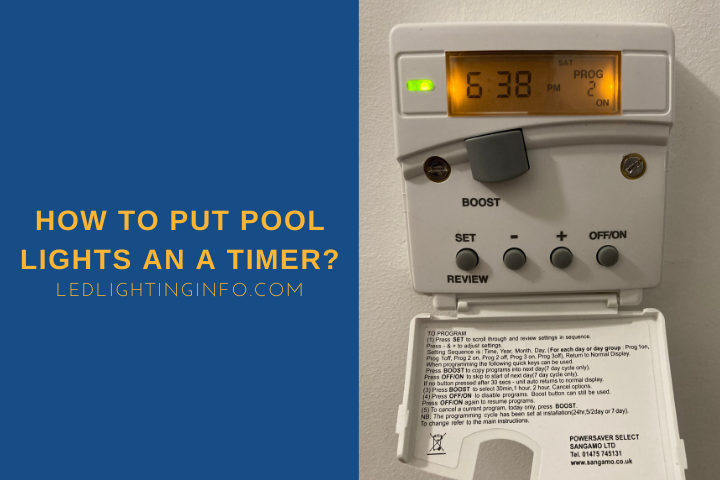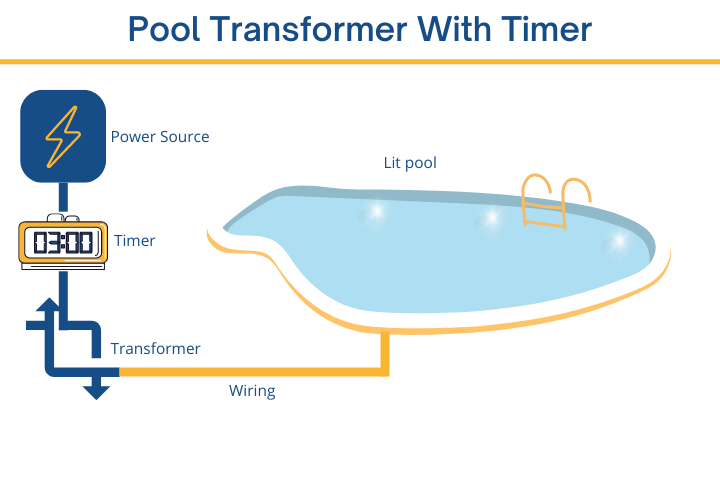Typically, you will want to use your pool lights at the same time every day.
During the summer months, when you’re more likely to be using your pool, you don’t need them on during the day or in the middle of the night when you’re asleep.
So you’ll likely want them on during the twilight hours of the evening.
The easiest way to do this is through a timer – that way, you can automate your lights to switch on and off without needing to get involved.
You can install any electrical timer on your lighting circuit, provided it matches the voltage. You should shield it in a waterproof case. You can add a timer before or after the transformer for low-voltage lights, provided you choose one that matches the voltage. Adding it before the transformer is easier as the high voltage timers are more common.
Let’s delve a little deeper by looking at:
- The different kinds of pool light times you can buy
- How to add a timer to your pool lights
- Where to install the timer on a low voltage circuit
What Are The Different Types Of Pool Light Timers?

Whenever you buy a timer for any electrical system, you usually have two options – mechanical and digital. The same applies to pool lights.
Mechanical and digital timers let you set the times your lights switch on and off. However, they each have advantages and disadvantages too.
Generally, a digital timer is seen as a more premium option, but you can use either.
Mechanical timers use physical switches to let you determine when the lights should switch on and off.
They work in different ways – some may only have a single on-and-off toggle, which you rotate around a dial representing the time.
Others will have individual switches representing each timeslot, perhaps every 30 minutes or an hour. The lights will be switched on for every button flipped to the inside of the dial.
Depending on your chosen timer, the main downside to mechanical timers is that they aren’t as flexible – you’re restricted to the customization of the toggles.
You can’t set different daily times and must adjust them manually to compensate for Daylight Savings.
Digital timers are a lot more clever. These don’t have mechanical switches; instead, you’ll use buttons to program your time on a digital screen.
The good thing with digital timers is that you have much more flexibility in your options.
You can set the time by the minute instead of at 30-minute or 60-minute intervals.
You can also program the timer for different days. Know that you spend every Friday evening away from home?
You can make sure the pool lights don’t switch on unnecessarily.
Plus, some digital timers will automatically adjust for Daylight Savings, so you don’t need to reprogram it every six months.
The downsides to digital timers are that they are more expensive and they’re a little less intuitive to use.
With a mechanical timer, you can work out how to use it just by looking at it. But first, you will need to read the manual with a digital timer.
It’s not a significant issue, but if you need to change something, you should find the manual first to remind yourself how.
One thing that’s worth noting is that you don’t get dedicated timers just for pool lights. In theory, any timer will do.
But some timers are manufactured for outdoor electricals such as pool lights, pumps, heaters, etc.
Their fundamental difference is their housing – they are usually already provided in a sealed box rated for outdoor use.
You could buy another timer and install your own weatherproof box. Still, there’s no real need when companies like Intermatic already provide a range of suitable outdoor-use mechanical and digital timers.
How To Put A Timer On Existing Pool Lights?

Wiring a timer into your existing pool light circuit is relatively easy.
They work as circuit interrupters.
So you must ensure they’re wired into your circuit between the main power and the lights themselves.
They’re designed to be wall-mounted if used outdoors, so typically you’d install a timer on the wall and then run the cable from the circuit breaker to the timer and then from the timer to your light junction box.
Here’s how to do it:
- Switch off the power at the circuit breaker
- Locate the wire that runs to your lights’ junction box
- Install the timer on a suitable surface (depending on the instructions provided) within easy reach of the cable
- Cut the cable close to the transformer, strip it by around a half-inch, and wire the live, neutral, and ground wires into the relevant terminals on both the live and load sides of the timer
- The wire running from the power source should be connected to the live terminals. The cable running to the light junction box is wired to the load terminals.
The only issue you may have here is if your existing cable needs more give to let you install the timer.
If that’s the case, you’re going to need to splice in new cable. So first, cut the existing cable and then add a new cable that’s at least AWG 14 thickness, though AWG 12 would be better.
Make sure you weatherproof the splice.
Chances are you will have a light switch on your pool lighting circuit – otherwise, they would be constantly on. You have two options here:
- Replace the light switch with the timer. This is the better choice for digital timers since you have complete control at all times
- Add the timer after the light switch in the circuit. You can turn the lights off completely at the switch or leave it on to work with the timer.
If you have both a light switch and a digital timer, be aware that turning off the power to the timer may cause it to reset.
Should Timer Be Installed Before Or After Transformer?
Many modern pool lights are low voltage and have a transformer wired into the circuit.
It’s, therefore, a valid question to know where to install the timer. Before the transformer or after?
You can actually get timers for both – what matters is the voltage.
Because before the transformer, the circuit’s current is at 120 volts.
Meanwhile, after the transformer, that power was lowered to around 12 volts.
If you install a 120-volt timer after a transformer, it won’t work.
If you install a 12-volt timer before the transformer, you’ll destroy it.
Most timers are 120 volts, so generally, people tend to install them before the transformer.
You can sometimes find a pool lights transformer with a timer built in, which can make things even easier – you only need to wire in one device, rather than two.
Final Words
Adding a timer to your pool light circuit makes a lot of sense – you’ll likely want to have your lights switched on or off at similar times of the day, and this can do it for you automatically.
The alternative would be to consider a smart pool light system such as iAquaLink, where you can control them from your phone and set up schedules – but a timer is a simple and significantly cheaper option.
Do you have a timer on your lights, or have you already opted for a smart lighting system?


